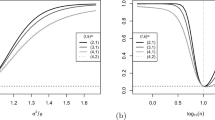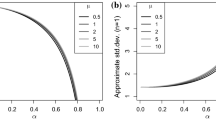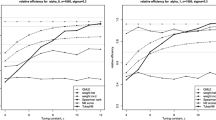Abstract
Popular goodness-of-fit tests like the famous Pearson test compare the estimated probability mass function with the corresponding hypothetical one. If the resulting divergence value is too large, then the null hypothesis is rejected. If applied to i. i. d. data, the required critical values can be computed according to well-known asymptotic approximations, e. g., according to an appropriate \(\chi ^2\)-distribution in case of the Pearson statistic. In this article, an approach is presented of how to derive an asymptotic approximation if being concerned with time series of autocorrelated counts. Solutions are presented for the case of a fully specified null model as well as for the case where parameters have to be estimated. The proposed approaches are exemplified for (among others) different types of CLAR(1) models, INAR(p) models, discrete ARMA models and Hidden-Markov models.



Similar content being viewed by others
References
Al-Osh MA, Aly E-EAA (1992) First order autoregressive time series with negative binomial and geometric marginals. Commun Stat Theory Methods 21(9):2483–2492
Alzaid AA, Al-Osh MA (1988) First-order integer-valued autoregressive process: distributional and regression properties. Stat Neerl 42(1):53–61
Alzaid AA, Al-Osh MA (1990) An integer-valued pth-order autoregressive structure (INAR(p)) process. J Appl Probab 27(2):314–324
Cressie N, Read TRC (1984) Multinomial goodness-of-fit tests. J R Stat Soc Ser B 46(3):440–464
Du J-G, Li Y (1991) The integer-valued autoregressive (INAR(p)) model. J Time Ser Anal 12(2):129–142
Duchesne P, de Micheaux PL (2010) Computing the distribution of quadratic forms: further comparisons between the Liu–Tang–Zhang approximation and exact methods. Comput Stat Data Anal 54(4):858–862
Ferland R, Latour A, Oraichi D (2006) Integer-valued GARCH processes. J Time Ser Anal 27(6):923–942
Francq C, Zakoïan J-M (2013) Estimating the marginal law of a time series with applications to heavy-tailed distributions. J Bus Econ Stat 31(4):412–425
Freeland RK, McCabe BPM (2004) Forecasting discrete valued low count time series. Int J Forecast 20(3):427–434
Grunwald G, Hyndman RJ, Tedesco L, Tweedie RL (2000) Non-Gaussian conditional linear AR(1) models. Aust N Z J Stat 42(4):479–495
Horn SD (1977) Goodness-of-fit tests for discrete data: a review and an application to a health impairment scale. Biometrics 33(1):237–247
Ibragimov I (1962) Some limit theorems for stationary processes. Theory Probab Appl 7(4):349–382
Jacobs PA, Lewis PAW (1983) Stationary discrete autoregressive-moving average time series generated by mixtures. J Time Ser Anal 4(1):19–36
Johnson NL, Kotz S, Balakrishnan N (1997) Discrete multivariate distributions. Wiley, Hoboken
Jung RC, Tremayne AR (2011) Useful models for time series of counts or simply wrong ones? AStA Adv Stat Anal 95(1):59–91
Kim H-Y, Weiß CH (2015) Goodness-of-fit tests for binomial AR(1) processes. Statistics 49(2):291–315
Kißlinger A-L, Stummer W (2016) Robust statistical engineering by means of scaled Bregman distances. In: Agostinelli C et al (eds) Recent advances in robust statistics: theory and applications. Springer, New Delhi, pp 81–113
McKenzie E (1985) Some simple models for discrete variate time series. Water Resour Bull 21(4):645–650
McKenzie E (1986) Autoregressive moving-average processes with negative-binomial and geometric marginal distributions. Adv Appl Probab 18(3):679–705
Meintanis S, Karlis D (2014) Validation tests for the innovation distribution in INAR time series models. Comput Stat 29(5):1221–1241
Moore DS (1982) The effect of dependence on chi squared tests of fit. Ann Stat 10(4):1163–1171
Neumann MH (2011) Absolute regularity and ergodicity of Poisson count processes. Bernoulli 17(4):1268–1284
Read TRC, Cressie N (1988) Goodness-of-fit statistics for discrete multivariate data. Springer, New York
Ristić MM, Bakouch HS, Nastić AS (2009) A new geometric first-order integer-valued autoregressive (NGINAR\((1)\)) process. J Stat Plan Inference 139(7):2218–2226
Schweer S (2015) On the time-reversibility of integer-valued autoregressive processes of general order. In: Steland A et al (eds) Stochastic models, statistics and their applications. Springer proceedings in mathematics & statistics, vol 122. Springer, Berlin, pp 169–177
Schweer S, Weiß CH (2014) Compound Poisson INAR(1) processes: stochastic properties and testing for overdispersion. Comput Stat Data Anal 77:267–284
Steutel FW, van Harn K (1979) Discrete analogues of self-decomposability and stability. Ann Probab 7(5):893–899
Tan WY (1977) On the distribution of quadratic forms in normal random variables. Can J Stat 5(2):241–250
Tavaré S, Altham PME (1983) Serial dependence of observations leading to contingency tables, and corrections to chi-squared statistics. Biometrika 70(1):139–144
Weiß CH (2008) Serial dependence and regression of Poisson INARMA models. J Stat Plan Inference 138(10):2975–2990
Weiß CH (2013) Serial dependence of NDARMA processes. Comput Stat Data Anal 68:213–238
Weiß CH (2018) An introduction to discrete-valued time series. Wiley, Chichester
Weiß CH, Pollett PK (2012) Chain binomial models and binomial autoregressive processes. Biometrics 68(3):815–824
Zucchini W, MacDonald IL (2009) Hidden Markov models for time series: an introduction using R. Chapman & Hall/CRC, London
Acknowledgements
The author thanks the Editor, the Associate Editor and the referees for carefully reading the article and for their comments, which greatly improved the article. The iceberg order data of Sect. 3.4 were kindly made available to the author by the Deutsche Börse. Prof. Dr. Joachim Grammig, University of Tübingen, is to be thanked for processing of it to make it amenable to data analysis. I am also very grateful to Prof. Dr. Robert Jung, University of Hohenheim, for his kind support to get access to the data.
Author information
Authors and Affiliations
Corresponding author
Ethics declarations
Conflict of interest
On behalf of all authors, the corresponding author states that there is no conflict of interest.
Appendices
Specific models for count processes
The subsequent models are used in the main part of this article to illustrate the derivation of the asymptotic distributions of the considered goodness-of-fit tests.
1.1 CLAR(1) model
Many important models for count Markov chains belong to the class of conditional linear autoregressive models of order one (CLAR(1) models) as discussed by Grunwald et al. (2000). The homogeneous count Markov chain \((X_t)_{\mathbb {Z}}\) is said to have CLAR(1) structure if the conditional mean of \(X_t\) is linear in \(X_{t-1}\), i. e., if
The condition \(|\alpha |<1\) guarantees a finite stationary mean given by \(\mu :=E[X_t]=\beta /(1-\alpha )\). If also the stationary variance of \(X_t\) is finite, i. e., \(\sigma ^2:=V[X_t]<\infty \), then the autocorrelation function (ACF) is of AR(1)-type, i. e., it altogether holds that
1.2 INAR models
If X is a discrete random variable with range \(\mathbb {N}_0\) and if \(\alpha \in (0;1)\), then the random variable \(\alpha \circ X := \sum _{i=1}^{X} Z_i\) is said to arise from X by binomial thinning (Steutel and Harn 1979). Here, the \(Z_i\) are i. i. d. binary random variables with \(P(Z_i=1)=\alpha \), which are also independent of X. Hence, \(\alpha \circ X\) has a conditional binomial distribution given the value of X, i. e., \(\alpha \circ X|X\ \sim {\text{ Bin }}(X,\alpha )\). The boundary values \(\alpha =0\) and \(\alpha =1\) might be included into this definition by setting \(0\circ X := 0\) and \(1\circ X := X\).
Using the random operator “\(\circ \)”, McKenzie (1985) defined the INAR(1) model in the following way.
Definition A.2.1
(INAR(1) Model) Let the innovations\((\epsilon _t)_{\mathbb {Z}}\) be an i. i. d. process with range \(\mathbb {N}_0\), denote \(E[\epsilon _t]=\mu _{\epsilon }\), \(V[\epsilon _t]=\sigma _{\epsilon }^2\). Let \(\alpha \in (0;1)\). A process \((X_t)_{\mathbb {Z}}\) of observations, which follows the recursion
is said to be an INAR(1) process if all thinning operations are performed independently of each other and of \((\epsilon _t)_{\mathbb {Z}}\), and if the thinning operations at each time t as well as \(\epsilon _t\) are independent of \((X_s)_{s<t}\).
The most popular instance of the INAR(1) family is the Poisson INAR(1) model (McKenzie 1985), which assumes the innovations \((\epsilon _t)_{\mathbb {Z}}\) to be i. i. d. according to the Poisson distribution \({\text{ Poi }}(\lambda )\). A Poisson INAR(1) process is an irreducible and aperiodic Markov chain with a unique stationary marginal distribution for \((X_t)_{\mathbb {Z}}\), the Poisson distribution \({\text{ Poi }}(\mu )\) with \(\mu =\frac{\lambda }{1-\alpha }\). It is also \(\alpha \)-mixing with geometrically decreasing weights (Schweer and Weiß 2014). Furthermore, the Poisson INAR(1) model constitutes the only instance within the INAR(1) family, which is time reversible (McKenzie 1985; Schweer 2015).
The (Poisson) INAR(1) model belongs to the class of CLAR(1) models, so it satisfies (A.2). The h-step-ahead transition probabilities are given by (Freeland and McCabe 2004)
and \((X_t,X_{t-h})\) are bivariately Poisson distributed (Johnson et al. 1997) according to \({\text{ BPoi }}\big (\alpha ^h\,\mu ;\ (1-\alpha ^h)\,\mu , (1-\alpha ^h)\,\mu \big )\) (Alzaid and Al-Osh 1988). Here, \({\text{ BPoi }}(\lambda _0;\ \lambda _1, \lambda _2)\) refers to the joint distribution of \((Y_0+Y_1, Y_0+Y_2)^{\top }\) with independent Poisson variates \(Y_i\sim {\text{ Poi }}(\lambda _i)\) for \(i=0,1,2\).
A simple example of an INAR(1) process not being time reversible is the geometric INAR(1) process (McKenzie 1985, 1986), which has marginal distribution \({\text{ Geom }}(\pi )\), i. e., \(P(X_t=x)=\pi \,(1-\pi )^x\). Here, the innovations stem from a zero-inflated geometric distribution,
with pmf \(P(\epsilon =x) = \delta _{x,0}\,\alpha + (1-\alpha )\,\pi \,(1-\pi )^x\). Hence, the 1-step-ahead transition probabilities are computed as
It is also possible to obtain any other member of the family of negative binomial distributions as a marginal distribution by choosing an appropritae innovations’ distribution, see McKenzie (1986) for details.
It is also possible to extend the INAR(1) recursion in Definition A.2.1 to a pth-order autoregression of the form
Due to the stochastic nature of the thinnings involved in (A.6), however, additional assumptions concerning the thinnings \((\alpha _1\circ X_{t},\ldots , \alpha _p\circ X_{t})\) are required. While the INAR(p) model by Du and Li (1991) assumes the conditional independence of \((\alpha _1\circ X_{t},\ldots , \alpha _p\circ X_{t})\) given \(X_t\), the one by Alzaid and Al-Osh (1990) supposes a conditional multinomial distribution. As shown by Schweer (2015), only the latter model continues the INAR(1)’s property that we have time reversibility exactly in the case of Poisson innovations (then also the observations are Poisson-distributed), while the INAR(p) model by Du and Li (1991) is neither time reversible nor does it have Poisson marginals. For this reason, we shall focus here on the time reversible Poisson INAR(p) model according to Alzaid and Al-Osh (1990), where the innovations are i. i. d. \({\text{ Poi }}(\lambda )\) and, hence, the observations have the stationary marginal distribution \({\text{ Poi }}(\mu )\) with \(\mu =\lambda /(1-\alpha _{\bullet })\).
Example A.2.2
(Poisson INAR(2) Model) Solving the Yule–Walker-type equations (3.6) and (3.8) in Alzaid and Al-Osh (1990), the ACF of the Poisson INAR(2) model becomes
As shown in Appendix B, the lagged observations \(X_t\) and \(X_{t-h}\) with \(h\in \mathbb {N}\) are bivariately Poisson distributed,
with conditional mean \(E[X_t\ |\ X_{t-h}]\, =\, \rho (h)\,X_{t-h}+\big (1-\rho (h)\big )\,\mu \).
1.3 Binomial AR(1) model
In many applications, it is known that the observed count data cannot become arbitrarily large, but their range has a natural upper bound \(n\in \mathbb {N}\) that can never be exceeded. For the case of such time series of counts supported on \(\{0,\ldots ,n\}\), McKenzie (1985) proposed the binomial AR(1) model.
Definition A.3.1
(Binomial AR(1) Model) Let \(\rho \in \big (\max {\{-\frac{\pi }{1-\pi }, -\frac{1-\pi }{\pi }\}}\ ;\ 1\big )\) and \(\pi \in (0;1)\). Define \(\beta :=\pi \cdot (1-\rho )\) and \(\alpha :=\beta +\rho \). Fix \(n\in \mathbb {N}\). The process \((X_t)_{\mathbb {Z}}\), defined by the recursion
where all thinnings are performed independently of each other, and where the thinnings at time t are independent of \((X_s)_{s<t}\), is referred to as a binomial AR(1) process.
The condition on \(\rho \) guarantees that the derived parameters \(\alpha ,\beta \) satisfy \(\alpha ,\beta \in (0;1)\), i. e., these parameters can indeed serve as thinning probabilities.
It is known that \((X_t)_{\mathbb {Z}}\) is a stationary, ergodic and \(\phi \)-mixing finite Markov chain (again with geometrically decreasing weights), the marginal distribution of which is \({\text{ Bin }}(n,\pi )\) (McKenzie 1985; Kim and Weiß 2015). The binomial AR(1) model belongs to the class of CLAR(1) models, so it satisfies (A.2), and it is time reversible (McKenzie 1985). The h-step-ahead transition probabilities are given by (Weiß and Pollett 2012)
where \(\beta _h:=\pi \cdot (1-\rho ^h)\) and \(\alpha _h:=\beta _h +\rho ^h\).
1.4 NDARMA model for counts
The “new” discrete ARMA (NDARMA) models have been proposed by Jacobs and Lewis (1983). They generate an ARMA-like dependence structure through some kind of random mixture.
Definition A.4.1
(NDARMA Model for Counts) Let the observations \((X_t)_{\mathbb {Z}}\) and the innovations \((\epsilon _t)_{\mathbb {Z}}\) be count processes, where \((\epsilon _t)_{\mathbb {Z}}\) is i. i. d. with \(P(\epsilon _t=i)=p_i\), and where \(\epsilon _t\) is independent of \((X_s)_{s<t}\). The random mixture is obtained through the i. i. d. multinomial random vectors
which are independent of \((\epsilon _t)_{\mathbb {Z}}\) and of \((X_s)_{s<t}\). Then \((X_t)_{\mathbb {Z}}\) is said to be an NDARMA(p, q) process if it follows the recursion
The stationary marginal distribution of \(X_t\) is identical to that of \(\epsilon _{t}\), i. e., \(P(X_t=i)=p_i=P(\epsilon _t=i)\), and we always have
The autocorrelations are non-negative and can be determined from the Yule–Walker equations (Jacobs and Lewis 1983)
where the r(i) satisfy
which implies \(r(i)=0\) for \(i<0\), and \(r(0)=\varphi _0\). Mixing properties have been established by Weiß (2013).
Bivariate distributions of INAR(2) model
We pick up the derivations of Alzaid and Al-Osh (1990) and extend them to obtain the bivariate distribution of \(X_t\) and \(X_{t-h}\) for \(h\in \mathbb {N}\). Let \((X_t)_{\mathbb {Z}}\) follow an INAR(2) model, where we first do not further specify the innovations’ distribution. Define the sequence of weights \((w_j)_{j\ge -1}\) by
which satisfy \(\sum _{j=0}^{\infty } w_j\,=\,1/(1-\alpha _{\bullet })\) (Alzaid and Al-Osh 1990 [p. 317]). Let us introduce a further sequence of coefficients \(({\varvec{a}}_j)_{j\ge -1}\) with \({\varvec{a}}_j=(a_{j,1},a_{j,2})^{\top }\):
Obviously, the first components are identical to the weights (B.1), \(a_{j,1}=w_j\) for all \(j\ge -1\), while the second components satisfy \(a_{j,2}=\alpha _2\,a_{j-1,1}=\alpha _2\,w_{j-1}\) for \(j\ge 0\).
Following Alzaid and Al-Osh (1990), p. 320, we define the bivariate process \(({\varvec{X}}_t)_{\mathbb {Z}}\) by \({\varvec{X}}_t=(X_t, \alpha _2\circ X_{t-1})^{\top }\), which is a Markov chain satisfying
In a first step, we extend this result to arbitrary time lags \(h\in \mathbb {N}\). Using the coefficients (B.2), we rewrite (B.3) as
Using the law of total expectation, we apply (B.4) and obtain
On the one hand, this implies the marginal pgf as
also see (4.4) and Theorem 2.1 in Alzaid and Al-Osh (1990). On the other hand, we compute from (B.5) the lagged bivariate pgf as
This implies that
Now, we turn to the special case of the Poisson INAR(2) model (Example A.2.2), i. e., where the innovations \((\epsilon _t)_{\mathbb {Z}}\) satisfy \({\text{ pgf }}_{\epsilon }(z)\,=\,\exp {\big (\lambda \,(z-1)\big )}\). Using that \(\sum _{j=0}^{\infty } w_j\,=\,1/(1-\alpha _{\bullet })\) and that \(\mu =\lambda /(1-\alpha _{\bullet })\), (B.6) simplifies to
also see (5.1) in Alzaid and Al-Osh (1990). In particular, the stationary marginal distribution is \({\text{ Poi }}(\mu )\). The bivariate pgf (B.7) becomes
This expression can be further simplified by considering (B.1). It follows that
so we continue
Obviously, this pgf is symmetric in z and y, confirming the time reversibility. For \(h=1\), it simplifies to (5.3) in Alzaid and Al-Osh (1990). In particular, (B.9) shows that \((X_t,X_{t-h})\) are bivariately Poisson distributed according to \({\text{ BPoi }}\big (w_h\,\mu ;\ (1-w_h)\,\mu , (1-w_h)\,\mu \big )\), see Johnson et al. (1997). This implies the conditional mean
The proof of Example A.2.2 is completed by noting that the weights in (B.1) follow the same recursion as the ACF of the Poisson INAR(2) model, so \(w_h=\rho (h)\) for \(h\ge 0\) in this special case.
Rights and permissions
About this article
Cite this article
Weiß, C.H. Goodness-of-fit testing of a count time series’ marginal distribution. Metrika 81, 619–651 (2018). https://doi.org/10.1007/s00184-018-0674-z
Received:
Published:
Issue Date:
DOI: https://doi.org/10.1007/s00184-018-0674-z
Keywords
- Count time series
- Goodness-of-fit test
- Estimated parameters
- Asymptotic approximation
- Quadratic-form distribution




